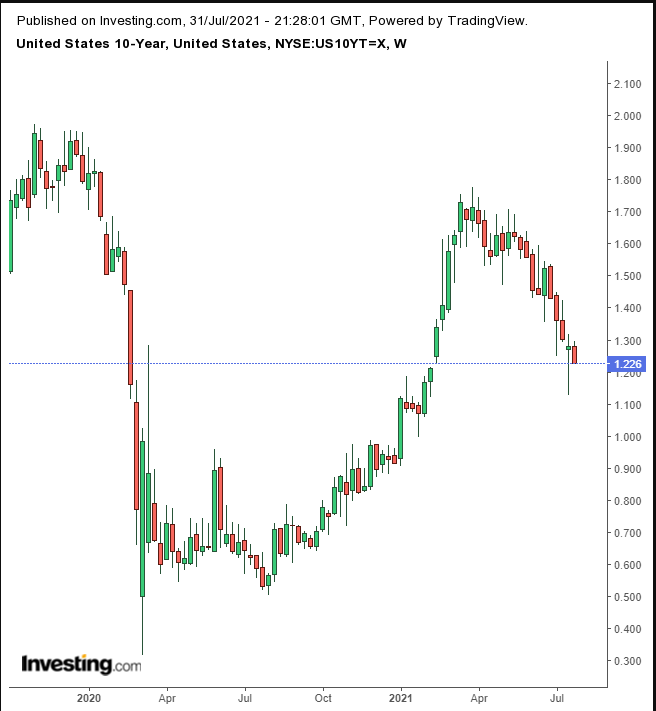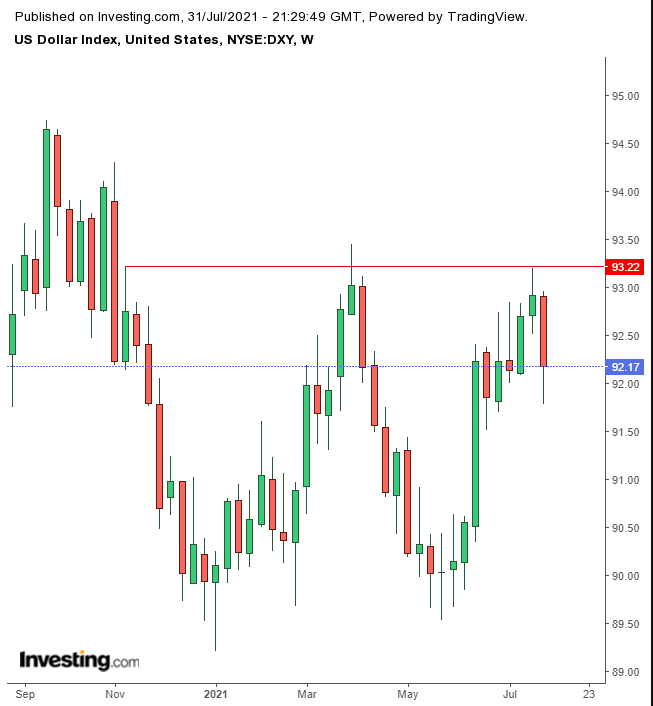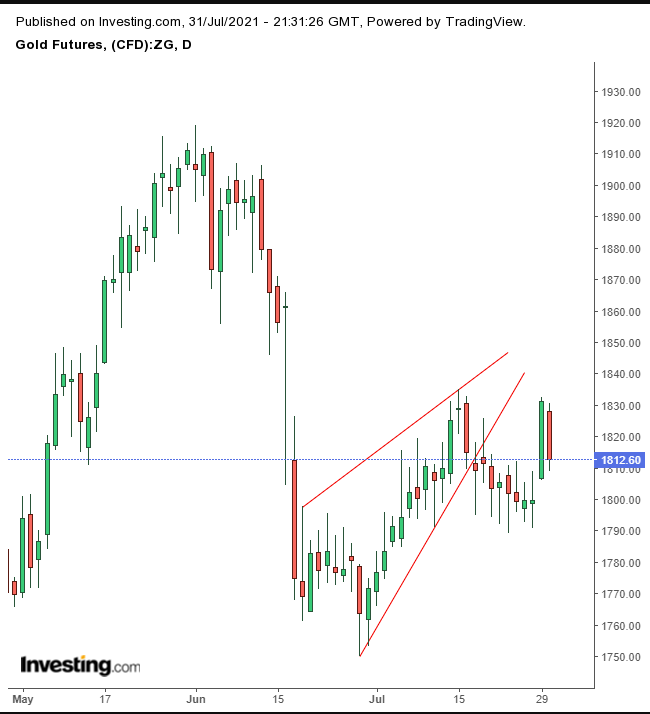- Employment data could be next market driver
- Bitcoin sees longest winning streak in eight years
- RBA, BoE rate decisions on tap
As the busiest week of the current earnings season came to a close on Friday, stocks ended lower, pressured by signs of weakness from the very megacap companies that, over the past year, boosted the market to new highs. Now, after worries about inflation, surging cases of the Delta variant of coronavirus worldwide, and better than expected earnings releases sparked investors to whipsaw between risk-off and risk-on sentiment, analysts are bracing for this coming Friday's monthly nonfarm payrolls print, which could be the next catalyst for another big market move.
Cyclical Rotation Back In Play?
Weak guidance from Amazon (NASDAQ:AMZN) on future sales—after the pandemic buoyed revenue in recent quarters—disappointed market expectations during the company's Thursday earnings release, and led to Friday's -7.56% rout in shares of the internet retail giant.
The mega-cap tech behemoth's stock proved to be the biggest drag on both the S&P 500 and the NASDAQ indices as the trading week came to a close, with all four major US indices finishing lower.
The Dow Jones plummeted because of another tech giant, Microsoft (NASDAQ:MSFT), which is heavily weighted in the 30-component index.
Amazon’s weaker sales forecast echoed the soft guidance presented by Facebook (NASDAQ:FB) and Apple (NASDAQ:AAPL) earlier in the week, bolstering the argument for a cyclical rotation that still hasn't actually followed through. Still, sectors that rely on an economic recovery outperformed this past week.
Materials jumped 2.8%, besting Energy’s 1.8% advance. That was followed by Financials which climbed 0.7%. On the opposite side of the equity spectrum, sectors that had benefited from social restrictions lagged: Communication Services dropped -1.3%, followed by the 0.7% selloff in Technology shares.
As we've pointed out, though, another segment of the market has been making a comeback—defensive shares. Utilities outperformed in July, adding 4.3% of value, beating tech stocks by almost 0.50%.
It turns out that Bank of America analysts recommend buying defensive. The lender predicts that mixed policy messages will steer the market into a correction in the second half of the year. What’s interesting about this situation is that defensives do well amid economic contraction—contrary to the Reflation Trade scenario.
Friday's retreat from another record occurred even as the second-quarter proved to be better than anticipated. Of the 60% of S&P 500 companies that have already reported, more than 80% beat on both sales and profits.
Still, stocks continue hovering near all-time highs, even with the big, marquee names that have led the rallies foreseeing peak sales. The specter of inflation remains an ongoing concern, and investors are justifiably getting nervous.
As valuations get stretched, anxious money managers are likely to keep fidgety fingers on the sell button—for a variety of reasons that extend beyond the virus and inflation: China's regulatory crackdowns, US-China trade relations to name just a few additional potential triggers for a selloff.
As well, some analysts see improving employment data as a key driver for forcing the Fed’s hand into removing easy accommodation. That would surely fuel a market correction.
As investor worries about equities escalate, they continue buying Treasuries, a sign of growing pessimism.

As such, yields, including for the 10-year benchmark note, were driven to their lowest weekly levels since February.
The dollar rose on Friday.

However, the greenback collapsed on a weekly basis, erasing two weeks of gains, demonstrating resistance at what would be the neckline of a massive double-bottom.
Conversely, gold climbed for the week.

Nevertheless, the yellow metal's drop on Friday evidenced resistance at a bearish flag.
For a tenth straight day, Bitcoin gained on Friday, accelerating past $42K to its highest level since May 20, its longest winning streak in 8 years.

Though the most popular cryptocurrency by market cap is currently back below the $42,000 level, remember that the $40,000 level was considered an inflection point by analysts. That line may mark a bottom.
WTI closed right under $74, as tightening global supplies offset concerns surrounding the Delta strain of the coronavirus. Indeed, many analysts see the bullish trend continuing for oil.
Week Ahead
All times listed are EDT
Sunday
21:45: China – Caixin Manufacturing PMI: seen to edge lower, to 51.0 from 51.3.
Monday
3:55: Germany – Manufacturing PMI: expected to remain flat at 65.5.
4:30: UK – Manufacturing PMI: forecast to stay unchanged as well, at 60.4.
10:00: US – ISM Manufacturing PMI: predicted to edge a bit higher, to 60.9 from 60.6.
Tuesday
00:30: Australia – RBA Interest Rate Decision: the central bank is forecast to hold at 0.10%.
18:45: New Zealand – Employment Change: expected to tick higher, to 0.7% from 0.6% QoQ.
21:30: Australia – Retail Sales: anticipated to plunge to -1.8 from 0.4%.
Wednesday
4:30: UK – Services PMI: to remain flat at 57.8.
8:15: US – ADP Nonfarm Employment Change: foreseen to rise to 700K from 692K.
10:00: US – ISM Non-Manufacturing PMI: predicted to edge up to 60.4 from 60.1.
10:30: US – Crude Oil Inventories: last week's print showed a drawdown of -4.089M Bbls.
Thursday
4:30: UK – Construction PMI: likely to rise to 63.8 from 63.3.
7:00: UK – BoE Interest Rate Decision: forecast to remain at 0.10%.
8:30: US – Initial Jobless Claims: predicted to fall to 380K from 400K.
Friday
8:30: US – Nonfarm Payrolls: forecast to rise to 900K from 850K.
8:30: US – Unemployment Rate: to dip to 5.7% from 5.9%.
8:30: Canada – Employment Change: expected to drop to 150.0K from 230.7K.
10:00: Canada – Ivey PMI: previously printed at 71.9.
